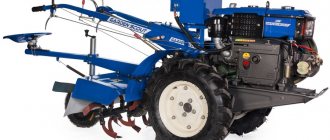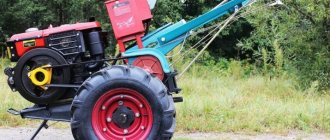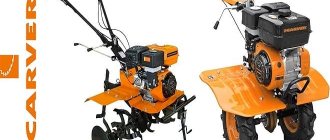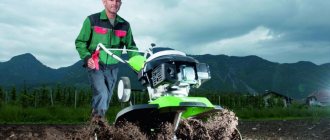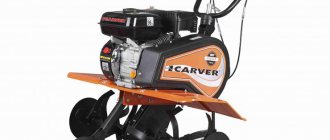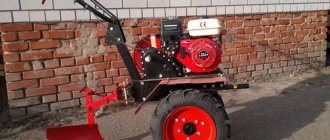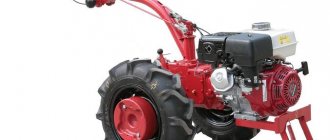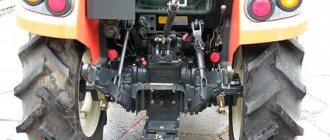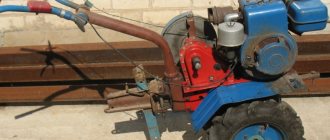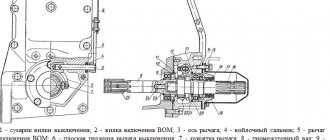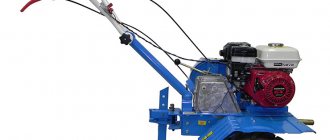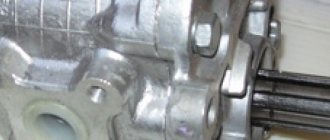People ask what qualities the Pecheneg walk-behind tractor has, and whether it is worth purchasing this machine for cultivating a plot of land. Farmers who value time and care about their farms have long been using walk-behind tractors and cultivators on their lands. Belorusskaya offers customers walk-behind tractors that can be used on plots of different sizes, in the field or near the estate.
What is a walk-behind tractor
The name of this type of technology speaks for itself.
The mechanized unit operates on the basis of an engine, which can be gasoline or diesel. The gearbox shaft is supplemented with a right and left motor - attachments are attached to it, which is responsible for expanding the functionality of the device. Wheels with powerful tires are responsible for moving the walk-behind tractor. Adhered dirt is independently cleared from the wheels while moving on the ground, provided that they are installed correctly based on the direction of their rotation. You can find out how to install the wheels from the instructions for the walk-behind tractor.
The walk-behind tractor engine can be gasoline or diesel
A special lever is provided to adjust the lift height and steering angle. The battery is a non-removable self-charging battery.
Types and prices of walk-behind tractors and attachments for them
The functionality of a walk-behind tractor depends on the number of attachments, because they are responsible for performing various tasks. Such devices can be included in the basic equipment package or purchased separately.
Of course, the more versatile and functional the device, the higher its price, so it is advisable to initially decide what additions to the walk-behind tractor you need right away, and then purchase additional elements as necessary.
Functional unit for different types of site treatment
You can make many details yourself, for example, you can easily find drawings and videos of potato planters for a walk-behind tractor with your own hands. Or you can modify the device by making snowmobiles from walk-behind tractors with your own hands. So, you will save money and get equipment that perfectly suits your needs, because independent work is more profitable than the prices of snowmobile attachments for walk-behind tractors.
The following main types of attachments exist:
- mowers: they can be mounted, frontal or rotary; they are used to mow tops, care for the lawn and make hay. You can make a mower for a walk-behind tractor with your own hands or buy a factory model for 8,500 rubles or more;
- hillers: there are paired, single, disk, ploughshares. They are used to hill up plants and loosen the soil between rows to remove weeds. The price starts at 400 rubles;
Attachments for walk-behind tractors
- cultivators: used for cultivating land and can also be used for harrowing the fertile soil layer. The cost of the factory model is about 3,500 rubles, although you can make a special attachment using a video harrow for a walk-behind tractor with your own hands;
- riding module: if it is necessary to process large areas of the site, such a module allows a person to sit. The cost of a plowing and riding cart starts from 10,300 rubles;
- trailer: used for transporting goods, can be regular or have a tipping body. You can do it yourself; drawings of trailers for walk-behind tractors are not difficult to find on the Internet. You can buy the product in the store for 13,700 rubles. and higher.
Walk-behind tractor with trailer for transporting crops
The best walk-behind tractor for the garden
To understand which walk-behind tractor would be best to purchase for your garden, you should decide on the criteria for its use and read reviews. Thus, the dimensions, design characteristics and performance of the unit must correspond to the area of the site, the characteristics of the land and the work performed. To cultivate virgin or neglected areas, it is recommended to buy units with significant weight, since simpler devices can simply “jump” out of the ground and require significant physiological force to keep them in the desired state.
Connoisseurs of functionality, maximum convenience and durability will appreciate devices with a massive power take-off and an intensive cutter. True, you will need to fork out a lot for them. The suspended equipment, which allows you to increase the list of capabilities of walk-behind tractors, also deserves some attention.
For example, potato planters provide a special opportunity to mechanize the process of planting potatoes, and potato diggers speed up and simplify harvesting. Adapters guarantee deep and smooth tillage, and trailers make it possible to transport loads of different sizes. It is important to understand that a walk-behind tractor helps speed up the process of cultivating the land, but does not reduce the physical activity of the operator. Thus, 10 acres of territory can be finished not in 2 days, as by hand, but in 3 hours.
To cultivate areas that have previously been treated many times, it is more correct to buy devices of small weight, since otherwise they will bury themselves in the ground under their own weight, which is why the operator will need to take action to return the device to its original location
In addition, when selecting the equipment itself, it is necessary to take into account what work will be carried out most often
A large and heavy tractor will work great with a hitch, but it is much less suitable for working with cutters than a small analogue. Consequently, for those who will use the walk-behind tractor mainly as a cultivator, it is necessary to give preference to units with a relatively low weight (70–80 kilograms). If the machine will be used more often with rear-mounted equipment (for example, a plow), then it is more correct to buy a unit weighing 100–120 kilograms.
Users in reviews on forums say the following about walk-behind tractors:
I recently bought a Garden Scout GS 101DE walk-behind tractor. Heavy and solid unit. It lifts so well that you are amazed. Good for cultivating any large areas of land.
I bought Mobile-K G85 D CH395. We can say that we were lucky; the walk-behind tractor turned out to be reliable and works perfectly. Good value for money.
I bought a Neva MB-23SD-27F walk-behind tractor and have been using it on the site for two years now. Overall, I am very pleased with the purchase; I have enough physical strength to work with the equipment. It took me a while to get used to the controls.
Model overview
In order to get some idea about walk-behind tractors with a power take-off shaft, it is necessary to become more familiar with the characteristics and features of some models.
NEVA MB-Compact S-6.0
The walk-behind tractor of this model is considered a real find for adherents of professional equipment. The unit has great functionality despite its compact size. Almost the entire range of mounted implements can be connected to the PTO, from a plow to a snow removal rotor.
Thanks to the design of the gearbox, which exhibits powerful traction characteristics, the walk-behind tractor is capable of plowing very hard soil using a low gear. In addition, the walk-behind tractor can be used to transport cargo weighing up to 500 kg.
The manufacturer specifies the following technical specifications:
- weight – 70 kg;
- power – 6 l. With.;
- low noise level;
- quick start and flawless operation in cold weather;
- cultivation depth up to 20 cm;
- high engine life;
- working width – 86 cm.
In addition, some modifications of the Neva can be equipped with an electric starter.
Agate (Salyut) 5P
The walk-behind tractor is used mainly for agricultural work on small farms. With the help of additional accessories, this unit can be used as a small tractor.
The walk-behind tractor is capable of hilling, plowing, removing snow, mowing hay, planting and harvesting potatoes.
Has a downshift function. When transporting cargo weighing up to 500 kg, it reaches a speed of 10 km/h.
Technical data:
- weight – 78 kg;
- power – 5 l. With.;
- plowing depth 25 cm;
- adjustable processing width up to 90 cm;
- The steering column is equipped with two position switches for comfortable control.
Belarus 09N-01
The model is designed for versatile soil cultivation over an area of up to 5 hectares. The unit is distinguished by its unpretentiousness to working conditions and reliability. Thanks to the mass, wheel traction with the soil surface and excellent control are ensured. Belongs to the severe type.
The following characteristics can be noted:
- unit weight – 176 kg;
- developed power – 9.38 liters. With.;
- working width is adjustable from 45 to 70 cm;
- number of gears – 4/2;
- load capacity – 650 kg;
- speed up to 11 km/h.
Profi 1900
The walk-behind tractors were specially developed by German manufacturers for carrying out agricultural operations in areas with heavy soil and poor traffic. Thanks to its power of 14 horsepower, this machine is capable of providing easy working conditions where considerable effort must be made with a conventional walk-behind tractor. For evening work, these models are equipped with a front headlight.
Attached Specifications:
- walk-behind tractor weight – 178 kg;
- power – 14 l. With. (in some models up to 18 hp);
- gripping processing width – 80-100 cm;
- plowing depth – 15-30 cm.
In addition, the walk-behind tractor is equipped with a cold start mechanism and a vibration damping system.
Chinese agricultural machinery mainly differs from other brands in its low price. It is good if cost reduction is achieved by increasing the quantity of products. But sometimes manufacturers from this country reduce the price of goods by installing low-quality components.
When choosing a walk-behind tractor from China, you should carefully read the reviews about both the company and the device itself.
One way or another, it is worth considering the most popular models.
Forte 105
Positioned as a multifunctional unit for performing agricultural operations on plots with a total area of up to 1.5 hectares. Used for cultivation, harvesting root crops, sowing seeds and many other tasks. The walk-behind tractor is able to withstand high loads for a long time.
Suitable for almost any soil, be it black soil or virgin soil.
Some technical data:
- average unit weight – 105 kg;
- power – 7 l. With.;
- processed width – 105 cm;
- processing depth – 35 cm;
- developed speed – 8 km/h;
- loading weight – 350 kg.
Weima WM1100BE
The walk-behind tractor, made according to Western standards, belongs to the heavy class units. The powerful engine is capable of fully providing high-quality functionality and completing all assigned tasks. The presence of a power take-off shaft allows the unit to operate with implements for various purposes throughout the year. This modification has an electric starter, which makes starting easier in extreme cold.
Characteristics:
- unit power – 9 l. With.;
- weight – 140 kg;
- processed depth – 30 cm;
- working width – 80-130 cm;
- load capacity – 300 kg;
- developed speed is 11 km/h.
Due to the fact that all of the listed machines are equipped with a power take-off shaft, the list of their functions is quite extensive. Therefore, such units are considered indispensable assistants in the country house or garden.
You will learn how to make a power take-off shaft in the next video.
What type of fuel do you prefer?
In this context, all walk-behind tractors can be divided into three main categories.
- Electric. Most often this is a small type of walk-behind tractor. With this unit you can process up to 5-7 acres of land at a time. Most often they are used to loosen the soil in a greenhouse, where it is not possible to use an internal combustion engine. They can operate both from the mains and from a battery.
- Gas engine. They are equipped with models of medium and large sizes. As a rule, gasoline-powered internal combustion engines are 2-stroke or 4-stroke. The main criteria for choosing are the engine volume, measured in cubic cm, and its power, measured in hp.
- Diesel. Most often this is a single-cylinder 4-stroke internal combustion engine, installed on a medium and heavy walk-behind tractor. Diesel-powered appliances are more environmentally friendly and economical. But the price for their service is much higher. In addition, the fuel system itself is much more sensitive to high-quality fuel, which can be difficult to find outside the city.
In some cases, alterations occur. Owners of some gasoline walk-behind tractors adapt their devices to run on gas, which can lead to significant savings on fuel.
Attachments
By default, the motor cultivator is equipped with cutters and wheels for transportation. This is more than enough for soil cultivation. But if you set more global tasks for your equipment, you need to take care of purchasing attachments. The most popular types of attachments are:
Lugs
Virgin soil plow
Potato digger
Lawn cracker
Hiller
Scarifier
Almost all elements are attached to the trailed part of the cultivator. The exception is cutters and lugs that are installed on the cultivator shaft. The attachment is secured using a bolt and nut, or a pin and cotter pin. The first method is more reliable. But the second one can be used if there are no tools at hand. All these additions will allow you to create a universal device that will take on all the manual work with the soil.
Which one is better to choose?
When choosing a model, not only the listed parameters are important
It is necessary to pay attention to the type of clutch and type of fuel.
With belts or gearbox
The clutch of the equipment can have a single-disc or multi-disc design. There are models with belt drive. Varieties with disks are more reliable and stable, therefore they are installed on heavy, powerful machines. Based on the tasks that the walk-behind tractor will perform, models with a belt or gearbox are selected.
The durability of the equipment depends on the gearbox. Cheaper models are equipped with a non-separable part. If it fails, you will have to replace it with a new one. Collapsible options made of cast iron can be repaired, so there are more benefits.
Gear-chain and gear reducers are considered the best. Worm elements heat up quickly. When working with difficult soil, you will have to stop every half hour, otherwise the equipment will break down.
Diesel or petrol
Modern walk-behind tractors run on two types of fuel, so you have to decide which is more suitable: gasoline or diesel.
Gasoline engines have high power and performance. The devices are less noisy and lighter compared to diesel engines. During operation, they emit less exhaust gases. Equipment repair is not too expensive. Today, gasoline-powered equipment is the most popular.
Diesel units are more powerful, have high cross-country ability, and are suitable for processing large areas. Fuel is consumed economically and costs less. The disadvantages include the high price of the devices, noise, and heavy weight.
Walk-behind tractors are universal equipment that is suitable for performing almost any excavation work. With them, the work of farmers and summer residents will become much easier and more efficient. When choosing a suitable model, it is necessary to take into account the technical characteristics of the products and the tasks to be solved using the equipment.
Chain or gear
A chain drive is a mechanism for transmitting motion using toothed sprockets and chains. The mechanism has its own advantages:
- transmits movement over long distances;
- one chain can rotate several shafts;
- high transmission stability and efficiency.
The disadvantages include:
- increased noise level;
- intensive chain wear;
- gradual stretching of the chain;
- high price.
Chains come in roller, bushing and toothed types.
The gear reducer is more complex than all the others. During operation, it reduces engine speed and increases the power output of the unit. A good walk-behind tractor is equipped with such an air-cooled gearbox. It may have a reverse, allowing the walk-behind tractor to move backwards. Disassembling and replacing gears is not difficult. In Chinese-made installations, non-separable gearboxes are used. If they break, you need to replace the entire body along with the filling.
Motoblock “Forte-135”
This unit is designed to perform a wide variety of agricultural work. Most often it is used in the garden for plowing and cultivation. The device has a single-cylinder engine with a capacity of 9 liters. With. The cylinder volume is 406 cubic meters. see. Fuel tank capacity – 5 l. Cooling in this model is provided by air. The performance of the walk-behind tractor is good.
The starting system is manual. You can select two gears forward, and one gear back. The cultivation width is 1350 mm. Moreover, its depth is on average 180 mm. The maximum you can set the equipment to is 300 mm. The length of this unit is 1700 mm, and it weighs 160 kg. The price of a walk-behind tractor on the market fluctuates around 135,000 rubles.
Description of the Pecheneg PMB-900 walk-behind tractor
The Pecheneg PMB-900 walk-behind tractor has a cultivator used in various types of land work on different areas.
The standard package includes wheels and cutters, operating instructions and a passport for working equipment. Additionally, you can purchase a coulter, potato digger, snow blower, lawn mower, trailer and other tools.
Enlarged fenders allow the use of 10-inch wheels with lugs.
It is also possible to use mounted structures from others and Oka. To do this, attach a special extension adapter.
- Engine power - 7 l/s.
- Volume - 207 cm³.
- Plowing depth - 35 cm.
- Plowing width - 75-100 cm.
- Fuel capacity - 4 liters.
- The gearbox is three-speed (2 forward and 1 reverse).
- Gearbox type: cast iron.
- Country of origin: Belarus.
- Fuel type - AI-92 gasoline and diesel.
- The weight of the walk-behind tractor is 90 kg.
The price for different regions varies between 24-35 thousand rubles.
Reviews from the owners are mostly positive, because for such a reasonable amount they purchased a miracle of technology that made their farming life easier.
Some reviews, as about the previous model, say that the cutters consist of fragile steel, very thin and brittle, which breaks on hard ground (clay, soil).
The Pecheneg 900 and 950 walk-behind tractors, equipped with a cast-iron gearbox, unlike an aluminum one, stay more firmly on the surface, without burrowing into the ground when plowing, without entering drifts, because Such machines are heavier and easier to control.
The packaging of walk-behind tractors consists of plywood. The kit must include a product passport and operating instructions.
The improved steering wheel will allow owners to work on different planes of the earth; when turning, the unit moves smoothly, without leaving large furrows behind it. The steering wheel is also adjustable with a special lever: up and down, left and right.
Russian walk-behind tractors
Motoblocks from famous foreign manufacturers, although they have better reliability and quality compared to ours, still this does not justify their high price. Often their design and engines are technologically noticeably more complex, which in turn requires qualified service, original, expensive spare parts and consumables. And besides, it is very difficult to modify them even slightly with improvised means to perform certain tasks.
Russian walk-behind tractors are largely aimed at the Russian consumer, with an excellent price-quality ratio, easy to use and maintain. Yes, and you can improve them with your own hands using improvised means.
Neva MB-2B-6.5 Pro
Specifications
- Engine – Briggs & Stratton, 4-stroke, gasoline,
- Working volume – 205 cc.,
- Power – 6.53 hp,
- Fuel tank – 3.8 l.,
- Gearbox – manual, gears: 4 forward, 2 reverse,
- Weight – 98 kg.,
- The width of the treated surface is 86-127 cm,
- Wheels - pneumatic,
- Reverse – yes,
- PTO – yes,
- Price – 49,000 rubles.
Neva MB-2B is a middle-class walk-behind tractor with a massive frame, which classifies it as a professional equipment. As attachments, you can connect a lawn mower, potato planter and potato digger, milling cutter, plow, baler, snow rotor and other similar equipment to it.
Salyut 100 X-M2
Specifications
- Engine – Honda GX100, 4-stroke, petrol,
- Working volume – 190 cc.,
- Power – 6.5 hp,
- Fuel tank – 3.6 l.,
- Gearbox – manual, gears: 2 forward, 1 reverse,
- Weight – 78 kg.,
- The width of the treated surface is 35-60-80 cm,
- Wheels - pneumatic,
- Reverse – yes,
- PTO – yes,
- Price – 40,000 rubles.
Compact and lightweight mid-class walk-behind tractor with belt drive. All controls are concentrated on the steering wheel, which makes this walk-behind tractor ergonomically convenient to use. The following attachments can be connected via the PTO and to the frame: potato digger, potato planter, hiller, plow, lugs, blade shovel, snow blower, road brush, rotary mower.
Belarus 09N-01
Specifications
- Engine – Honda GX270, 4-stroke, petrol,
- Working volume – 270 cc.,
- Power – 9.38 hp,
- Fuel tank – 3.6 l.,
- Gearbox – manual, gears: 4 forward, 2 reverse,
- Weight – 176 kg.,
- The width of the treated surface is 45-70 cm,
- Wheels - pneumatic,
- Reverse – yes,
- PTO – yes,
- Price – 75,000 rubles.
This is a heavy-duty walk-behind tractor with a high-strength cast iron body, a disc clutch and a gear drive. Excellent functionality and good performance allow it to cultivate soil on an area of up to 5 hectares. Connectable attachments: plow, tiller, harrow, cultivator, rotary mower, trailer, blade, snow blower, hiller, potato planter, potato digger, utility brush, lugs, weighting agent.
Petrol walk-behind tractor PATRIOT Ural (440 10 7580) 7.8 hp.
Photo: market.yandex.ru
The PATRIOT URAL petrol walk-behind tractor is designed for processing and cultivating land in gardens and personal plots. Distinctive feature. This model is a frame that covers the engine and other components on top. The frame also acts as a carrying handle when loading or unloading from vehicles. A pulley mounted on the walk-behind tractor allows you to connect a mower or snow blower, and a Russian-style hitch makes it possible to use various attachments. Gear shifting is carried out by the gearbox, and low and high gears are engaged by throwing the belt from one pulley groove to another. The design and materials from which the walk-behind tractor is made ensure a long service life.
Petrol walk-behind tractor PATRIOT Ural (440 10 7580) 7.8 hp.
Advantages:
- Safety
- Convenience
- Reliability
- Patency
- Efficiency
Which walk-behind tractor to choose Neva
Today, the Neva walk-behind tractor line consists of five main platforms:
- MB-Compact (6.5 hp);
- MB-1 MultiAgro (5.8 - 6.5 hp);
- MB-2 (6.0 - 6.5 hp);
- MB-2 MultiAgro (5.8 - 6.5 hp);
- MB-23 (9.0 - 12.0 hp).
To understand which model is better to buy, you should proceed from the goals set for the walk-behind tractor. Consider the area of the area being processed, the type of soil, the physical capabilities of the operator, and the required characteristics for using certain mounted and trailed devices.
- MB-Compact with a classic gear-chain reducer is a lightweight walk-behind tractor, suitable for already cultivated soil of various types in small areas. Cultivation width is 65-97 cm, traction force is 120 kgf. This model is only compatible with original attachments. Even older people can handle such a unit weighing 70 kg.
- MB-1 with a MultiAgro gearbox is a lightweight walk-behind tractor with an increased number of gears. Unlike MB-Compact, it is also suitable for processing virgin soil in small areas. Cultivation width is 80-125 cm, traction force is 140 kgf.
- MB-2 with a classic gearbox is a mid-class walk-behind tractor. It differs from its lighter “brothers” in its frame design, wheels of larger diameter and the ability to unlock one wheel to make turning easier. Designed for processing any type of soil in medium-sized areas. The weight of the unit without attachment is 100 kg, the working width is 81-126 cm, the traction force is up to 300 kgf. You can install attachments of any brand on it, including homemade ones.
- MB-2 MultiAgro - a modified MB-2, has a more convenient handle adjustable in height and angle, (3+1)x2 speeds and biaxial unlocking.
- MB-23 is a heavy walk-behind tractor, which is produced both with a classic gearbox and with MultiAgro (8 forward speeds + 4 reverse, unlocking of two wheels). It is suitable for processing large areas with any type of soil. Weight – 100 kg, working width 81-126 cm, traction force – up to 300 kgf. It is possible to install attachments of any brand, including homemade ones.
Petrol walk-behind tractor Aurora COUNTRY 1100 MULTI-SHIFT 7 hp.
Photo: market.yandex.ru
The Aurora COUNTRY 1100 MULTI-SHIFT petrol walk-behind tractor is suitable for processing large areas. It has the ability to attach additional equipment, which will expand the range of application of the unit. Reliable gearing ensures long service life. The cast iron gear housing protects the unit from stones. Thanks to the 23 mm hex axles, wheels, cutters and lugs are firmly fixed.
Petrol walk-behind tractor Aurora COUNTRY 1100 MULTI-SHIFT 7 hp.
Advantages:
- Economical
- Design
- Easy engine starting
- Patency
- Safety
- Convenience
- Maneuverability
- Wide functionality
- Air cooling
- Easy to use
#2020 #Top 10
Read us first - add the site to your favorite sources.
Add a comment
{"commentics_url":"\/\/express-novosti.ru\/comments\/","page_id":1451045,"enabled_country":false,"enabled_state":false,"state_id":0,"enabled_upload": false,"maximum_upload_amount":3,"maximum_upload_size":5,"maximum_upload_total":5,"securimage":true,"securimage_url":"\/\/express-novosti.ru\/comments\/3rdparty\/securimage\ /securimage_show.php?namespace=cmtx_1451045″,”lang_error_file_num”:”\u041c\u0430\u043a\u0441\u0438\u043c\u0443\u043c %d \u0444\u0430\u0439\u043b\u043e\ u0432\u043c\u043e\ u0436\u0435\u0442 \u0431\u044b\u0442\u044c \u0437\u0430\u0433\u0440\u0443\u0436\u0435\u043d\u043e.","lang_error_file_size":"\u041f\u043e \u0436\u0430\u043b\ u0443\u0439\u0441\u0442\u0430, \u0437\u0430\u0433\u0440\u0443\u0437\u0438\u0442\u0435 \u0444\u0430\u0439\u043b \u0440\u0430\ u0437\u043c\u0435\u0440\u043e \u043c \u043d\u0435 \u0431\u043e\u043b\u0435\u0435 %d MB.","lang_error_file_total":"\u041e\u0431\u0449\u0438\u0439 \u0440\u0430\u0437\u043 c\u0435\u0440\ u0432\u0441\u0435\u0445 \u0444\u0430\u0439\u043b\u043e\u0432 \u0434\u043e\u043b\u0436\u0435\u043d \u0431\u044b\u0442\u044c \ u043d\u0435\u0431\u043e\u043b\ u0435\u0435 %d MB.","lang_error_file_type":"\u041c\u043e\u0436\u043d\u043e \u0437\u0430\u0433\u0440\u0443\u0436\u0430\u0442\u044c \u0442\u0 43e\u043b\u044c ""lang_text_loading":" u0437\u043a\u0430 ..","lang_placeholder_state":"\u0420\u0435\u0433\u0438\u043e\u043d","lang_text_country_first":"\u0421\u043d\u0430\u0447\u0430\u043b\u0430 \u0432\u044b\u04 31\u0435 \u0440\u0438\u0442\u0435 \u0441\u0442\u0440\u0430\u043d\u0443″,”lang_button_submit”:”\u0414\u043e\u0431\u0430\u0432\u0438\u0442\u04 4c","lang_button_preview":" \u041f\u0440\u0435\u0434\u0432\u0430\u0440\u0438\u0442\u0435\u043b\u044c\u043d\u044b\u0439 \u043f\u0440\u043e\u0441\u043c\u 043e\u0442\u0440″,”lang_button_remove ":"\u0423\u0434\u0430\u043b\u0438\u0442\u044c","lang_button_processing":"\u041f\u043e\u0434\u043e\u0436\u0434\u0438\u0442\u0435..."}
Popular Russian brands and their brief descriptions
- Neva. The manufacturer uses American and Japanese engines to create walk-behind tractors, which are characterized by high power and low fuel consumption. Models can run on gasoline or diesel. Suitable for processing small garden plots and vegetable gardens.
- Mole. The company produces three types of walk-behind tractors - low-power, powerful and elite. The former are equipped with two-stroke engines and are suitable only for cultivating small areas. The latter are equipped with two- and four-stroke engines, can plow to a width of 100 cm, and are used on large areas. The third group includes only one model Mole DDE TG-90H160, which can easily replace a conventional farm tractor.
- Caliber. Models are presented with different technical characteristics. They are distinguished by endurance, performance, and maneuverability due to the presence of reverse.
- Virgin land. The company produces only walk-behind tractors with 4-stroke engines. The structures have brackets for installing attachments. The wheels are equipped with a tread that provides good grip on the surface.
- Oka. This manufacturer offers many powerful models at low cost. The units can be supplemented with a power take-off mechanism to expand the arsenal of attachments. They have standard 3 speeds.
Rating of TOP 10 best models
| Place | Name | Price |
| TOP 5 best gasoline walk-behind tractors with power take-off shaft | ||
| 1 | PATRIOT Pobeda (440 10 7212) | 25 000 ₽ |
| 2 | PATRIOT Nevada 9 | 45 000 ₽ |
| 3 | CHAMPION BC1193 | 45 000 ₽ |
| 4 | PATRIOT Nevada | 47 000 ₽ |
| 5 | Tselina NMB-901 | 41 000 ₽ |
| TOP 5 best diesel walk-behind tractors with power take-off shaft | ||
| 1 | Weima WM1100BE (wheels 5x12) | 79 000 ₽ |
| 2 | PATRIOT Boston 9DE | 57 000 ₽ |
| 3 | Weima WM1100A (wheels 5x12) | 62 000 ₽ |
| 4 | CHAMPION DC1193E | 65 000 ₽ |
| 5 | Aurora SPACE-YARD 1350D | 82 000 ₽ |
Engine, gearbox and clutch
The engine is the most expensive and critical component of a walk-behind tractor. Therefore, saving on it means doing repairs every season instead of productive work.
The highest quality and most economical motors for these units are produced by GreenField, Subaru, Honda, Forza and BRIGGS & STRATTON. Chinese Lifan power units, produced under license from Honda, have proven themselves well.
Almost all manufacturers of walk-behind tractors today equip their machines with engines from the listed companies. Therefore, there is no point in buying a “pure” Honda, which will cost several times more than the unit on which the Honda engine is installed.
Regarding the number of engine cycles, we can confidently say that four-stroke engines are preferable to two-stroke engines, both in terms of efficiency and reliability.
The walk-behind tractor clutch can have a multi-disc or single-disc design, and is also implemented in the form of a belt drive. The first two types of clutch are more reliable, therefore they are used for installation on heavy machines.
Walk-behind tractor belt clutch
The gearbox of a walk-behind tractor is of great importance for its trouble-free operation, so you should definitely pay attention to it when choosing. Cheap units are equipped with non-removable gearboxes, which in case of breakdown have to be completely replaced
A dismountable, serviceable gearbox is more profitable in this regard, especially if it is made of cast iron rather than aluminum.
Gear reducer
The best design options for gearboxes are gear and gear-chain. The worm gearbox becomes very hot when operating at full load. This leads to the need to stop the walk-behind tractor every 20-30 minutes.
User manual
First launch and run-in
- The assembly process must occur in accordance with the recommendations in the operating instructions.
- Next, you should add oil and fuel, since they are not included in the factory configuration.
- Then comes the important point - running in. This is the first 6 hours of using Kubanets walk-behind tractors, when the engine parts are lubricated and rubbed against each other.
- During break-in, the device should be used under minimal loads. Driving with an empty trailer is best. Upon completion of break-in, change the engine oil.
Service
- The engine oil in Kuban walk-behind tractors should be changed after 20 engine hours. It is recommended to use semi-synthetic 10W-30.
- The transmission oil should be changed after 100 hours of operation of the Kubanets walk-behind tractor. The most suitable brands are Tap-15v or TAD-17i.
- Control levers should be lubricated with Litol-24 or Solidol.
You should always fill with clean and fresh fuel to avoid clogging the fuel system.
Basic faults and repairs
The most common breakdowns of Kubanets walk-behind tractors are:
- Filters are clogged (they need to be cleaned periodically);
- Faulty spark plugs (contact has come off, the gap has changed or carbon deposits have formed);
- Running out of fuel or oil;
- The starter cable is broken;
- The drive belt is broken;
- The carburetor settings are off.
The solution to each of these breakdowns is intuitive. If you suddenly have any questions, you can always refer to the operating instructions.
Pros. Why we love these walk-behind tractors!
- In fact, walk-behind tractors with a PTO are full-fledged tractors without rear wheels. They are capable of raising virgin soil on any type of soil (with the exception of UGRA NMB-1, this walk-behind tractor is a different story).
- When working with soil, they do all the work themselves. The operator does not help the walk-behind tractor, but only sets the angles and sets the direction.
- The hitch under the PTO is of the tractor type. Large grip, long service life, maximum efficiency due to torque transmission without losses due to belt slippage and other inconveniences of belt-operated walk-behind tractors.
- When installing the adapter, the walk-behind tractor turns into a full-fledged mini tractor.
- Full-fledged transmission with the ability to select the optimal operating speed in any mode.
- Working with an active cutter does not require repeated cultivation.
Based on the advantages, we can conclude:
These products will be useful for those who did not want to sit in the MTZ cab, but out of love for walking, decided to take a walk-behind tractor that will cope with all the MTZ tasks in a similar time frame.
Operating manual for walk-behind tractors “Kubanets”
Here you can briefly familiarize yourself with the instructions for the walk-behind tractor, its sections and information that helps the owner of the equipment learn how to properly care and operate the “Kubanets” walk-behind tractor. The instructions contain the following sections:
- The structure of the unit, its step-by-step assembly (diagrams and descriptions are attached).
- Safety rules when working with the device.
- Starting Guide.
- Running in the Kubanets walk-behind tractor.
- Maintenance of a motorized device.
- Possible malfunctions.
Specifications.
We invite you to familiarize yourself with the contents of some sections.
Run-in
The break-in procedure allows the moving parts of the walk-behind tractor to get used to running under minimal loads, this will increase the service life of the engine and transmission. The running time is about 8 hours. During this time, the owner of the equipment checks the performance of all mechanisms and components with a gradual increase in speed. Loads should not exceed more than 3-4 times the engine power. Before starting the break-in period you must:
- fill the fuel tank with fuel;
- fill the appropriate containers with engine and transmission oils;
- check the reliability of bolted connections;
- check tire pressure.
At the end of the break-in period, it is necessary to drain the used oil from the system and replace it with new one.
Maintenance
Proper care of a motorized device will extend its service life and minimize possible breakdowns. There are several stages of maintenance:
- Oil change:
- the gearbox uses Tap-15v, TAD-17i oils, they are replaced every 100 operating hours;
- The engine uses 10W-30 engine oil and is replaced every 25 hours.
- Daily Maintenance:
- care before operation includes: monitoring the level of working fluids (fuel and oils), monitoring bolt tension, tire pressure;
- After-use maintenance includes: cleaning and rinsing the motorized device, drying and lubrication.
- Preservation for storage:
- drain all oil and fuel;
- thoroughly clean and wash the walk-behind tractor;
- lubricate and store in a dry place.
- Scheduled inspection.
Malfunctions
We suggest that you familiarize yourself with the list of reasons that will prevent the walk-behind tractor from starting:
- The fuel tank has run out.
- Oil level is below normal.
- Low quality working fluids.
- Filters are clogged.
- There is no compression in the engine.
For gasoline walk-behind tractors:
- The high-voltage wire is broken.
- The spark plug has burned out.
- The candle is smoked.
- The ignition is not adjusted.
- The carburetor requires adjustment or cleaning.
- The magneto has failed.
- The flywheel blades are jammed by the magneto and need to be adjusted.
How to decide on the power unit of a motor cultivator
Soil cultivators are equipped with electric motors and internal combustion engines.
Cultivators with electric motors
Such units are driven by a special electric motor. In turn, the engine runs on mains power and is connected by a long cable. Everything is like at the beginning of the 20th century, only more powerful and lighter. In addition to its small dimensions, the advantages of the technology include the absence of harmful emissions into the air. When using the device, you will not have to inhale exhaust gases, which are already in abundance in the air.
But the main disadvantage of the electric cultivator is the cord. Firstly, this impairs its mobility, since if there is no outlet nearby, you will have to plow the ground manually. Secondly, you need to monitor the safety of the cable. If it is damaged by cutters, there is a risk of electric shock to the operator, which can lead to injury. The cost of the equipment is relatively low, but you shouldn’t expect high power either. Usually it does not exceed 2 - 3 kW (approximately 2.7 - 4 hp).
There are also cultivators with an electric motor powered by a battery without any cables. And this is the only noticeable difference between the models mentioned above. The battery is more mobile, but not superior in power. It is usually used in small areas when treating only the top layer of soil.
Motor cultivator with internal combustion engine
Petrol powered cultivators are the most popular. They have virtually no power limitations. The only thing that can put you off buying is the high price.
Gasoline motor cultivators are more difficult to maintain. The engine should be periodically cleaned of residual dust and soil and other maintenance procedures performed. Neglecting them can lead to problems or even serious damage. Due to the emission of exhaust gases, the device cannot be used in enclosed spaces.
Motor cultivators can be equipped with two types of internal combustion engines: two-stroke and four-stroke.
1. Two-stroke. They are cheaper and 60–70% more powerful than their four-stroke counterparts (with the same dimensions). But there are some disadvantages. The first is efficiency - the engine consumes more fuel. The second is reliability and resource. To avoid serious damage, you should use only high-quality fuel and oil. In addition, you must adhere to the recommended proportions of mixing the ingredients. Otherwise, the breakdown will occur much earlier than the allotted time. In terms of engine life, two-stroke engines are always inferior to four-stroke engines. By the way, repairing two-stroke engines is usually quite expensive. Therefore, damaged equipment is sent not to a workshop, but to a landfill. The owner goes for a new purchase. This type of engine can only be found on light models of cultivators.
Motor cultivator with two-stroke engine.
2. Four-stroke. Almost all new models are equipped with this engine. The first tangible advantage compared to the previous version is increased comfort. They boast lower noise levels. The mass is also different. Four-stroke ones are heavier, which only improves the performance of the equipment when plowing and loosening. The engine is also distinguished by its “cleanliness”. Four-stroke engines have much less harmful emissions into the air. And most importantly, equipment with this engine will last longer.
There is a widespread belief among gardeners that when working with a gasoline cultivator, periodic breaks should be taken to cool the engine. But in reality this is not necessary at all. To raise the temperature beyond normal limits, you need to spend more than one hour. In addition, the equipment tank has a limited volume, which is enough for several hours of operation. Accordingly, you will have to stop from time to time to refuel. During these few minutes, the engine will have time to cool down before the next refueling (if needed).
Motor cultivator with a four-stroke engine.
differences between 2 types of gearboxes | Topic author: Stanislav
Explain to a layman why chain gearboxes are better than worm gearboxes, with the exception of friction in the gear-worm pair
Vasily chain is the same belt, only without the slipping effect. .and the gear ratio is the diameter of the driven and driving sprockets. .but in general, the worm has one undeniable advantage. .lifted load by a WORM - will never lower on its own if the engine suddenly turns off. . the worm is like a ratchet. . blocks self-rotation. .other gearboxes do not have this effect. .as for walk-behind tractors, the worm is much more compact and durable than any chain transmission method.. besides, when earth gets on the chain, it “chews” it an order of magnitude faster..
Peter The gearbox itself is a mechanism and it is not correct to distinguish between what is better or worse. Each gearbox has its own purpose. As for chain or otherwise, this is just a way of transmitting rotation from one wheel to another. So, think carefully about your question, and then ask.
Ruslan Milok! Aren't you confusing anything? A chain is a type of drive, like a belt or clutch, and a worm is a type of transmission! Do you go to school?
Stepan You really asked the wrong question - not the gearbox, but the transmission. The chain wheel is simpler to make and has less friction, the distance between the drive and driven wheels can vary widely, but the worm wheel can withstand much greater loads
How to choose a walk-behind tractor?
Before purchasing a unit, you need to focus on the set of operations that the walk-behind tractor will have to perform. You should not buy the most expensive modifications of units that have a full range of functions in their arsenal. Not every model can cope with the task.
For example, in large areas with dense soil, the best option would be to purchase a heavy unit, while in a small dacha, a light-class walk-behind tractor will be sufficient.
When choosing, you also need to decide on the type of fuel on which the agricultural machine will operate. Units with a gasoline engine are quieter, lightweight, and easy to maintain. Diesel walk-behind tractors are noisier, but they take the cake with their high power. The disadvantage of diesel is its high price.
Please note that additional attachments may often be provided by another manufacturer. In this case, an adapter will be required to connect the implement to the purchased walk-behind tractor. This may result in unit malfunction or problems in performing the job.
The range of walk-behind tractors on the market today is quite diverse. Models from companies such as Husqvarna, Profi, Hyundai are in great demand. In our country and neighboring countries, such cars as “Belarus”, “Neva”, “Salyut-100” are presented. Of course, one should not discount the Chinese companies Forte and Wiema, because their products are also quite in demand.
If you compare foreign models with domestic analogues, you can see that their cost is not always justified by reliability and ease of use. In addition, imported models will require expensive consumables and the presence of experienced specialists for maintenance. Both can be very difficult to find.
Domestic companies are focused on ease of use and low cost. The decisive factor is the ability to repair the walk-behind tractor on your own.
Owner reviews
Alexander Yurievich, 49 years old:
The walk-behind tractor is not bad, the engine is excellent, the running-in was successful, but the assembly and quality of materials are a little let down - the steering column has a lot of play, the protective wings have peeled off, I’ve already painted them, they vibrate a lot during operation, I wonder how long they will last.
Dmitry, 35 years old:
I bought a heavy diesel model, it goes well with both the plow and cutters. With the adapter it goes easily, fatigue is unprecedented. The engine is a little noisy, the electric starter helps at any time of the year. I made a blade, I don’t put it on conservation for the second year - it works and clears the snow. The paint is peeling in places, I have to touch it up all the time. The first year I worked on cutters from the kit, then I switched to homemade ones - stronger ones.
The best medium-sized Russian walk-behind tractors
Tselina NMB-901
Powerful walk-behind tractor with a gasoline engine of the Lifan 177F series. It improves traction, reduces fuel consumption, is durable and reliable.
A distinctive feature is an automatic transmission with 3 main speed modes.
The equipment allows you to process areas of up to 1,200 square meters. m in a short period of time.
Characteristics:
- cultivation width - 72-113 cm, depth - 30 cm;
- engine type - 4-stroke with 1 cylinder, volume - 270 cc. cm, power - 9 l. With.;
- traction force - 15.5 kN, fuel consumption - 374 g per hour of operation;
- there is a power take-off shaft, disc clutch, gear reducer, reverse;
- noise level - 92 dB;
- fuel tank volume - 3.6 l;
- dimensions - 136x70x100 cm;
- weight - 123 kg.
Advantages:
- smooth running when switching speed mode;
- Russian quality, time-tested;
- suitable for equipping with attachments;
- strength of parts, durability.
Flaws:
not equipped with cutters.
Neva MB-2KS-(168FA)
Petrol model with manual transmission, gear-chain drive and 6 speed modes. Pneumatic wheels allow you to withstand the weight of a walk-behind tractor paired with attachments.
Smooth running and excellent maneuverability make the unit the best in its line.
Characteristics:
- plowing depth - 20 cm, width - 81-126 cm;
- there is a power take-off shaft, reverse;
- engine volume - 196 cubic meters. cm, power - 6.50 l. With.;
- fuel tank volume - 3.6 l;
- weight - 85 kg.
Advantages:
- high-quality cultivation of any soil for subsequent planting of various crops;
- convenient control due to a well-designed frame;
- controls are located on the handle;
- there is good traction between the wheels and the ground surface;
- saving fuel consumption, the ability to use any type of gasoline.
Flaws:
No.
Neva MB-23B-10.0
Decent model with original Briggs and Stratton petrol engine. The engine has high performance - 10.06 liters. With.
The walk-behind tractor perfectly demonstrates its capabilities in all weather conditions.
Wheel towing is eliminated, so the unit moves smoothly and quickly.
Characteristics:
- availability of 6 cutters with max. rotation - 160 rpm. minute;
- plowing depth - 20 cm, width - 86-127 cm;
- There is a manual transmission, reverse, gear reducer;
- weight - 105 kg.
Advantages:
- good maneuverability;
- high strength of structural elements;
- the unit has a long service life, designed for 10 years or more;
- cutters do not require additional processing or regular maintenance;
- fuel economy;
- affordable price.
Flaws:
No.
Neva MB-23-Y (MX300) with MultiAgro gearbox
Powerful walk-behind tractor with gear-chain drive, belt clutch, reverse and 6 speed modes. The uniqueness lies in the fact that the unit is equipped with a MultiAgro gearbox.
Thanks to it, the user can choose the appropriate speed, enjoy excellent maneuverability, appreciate the high-strength housing and streamlined shape of the gearbox.
Characteristics:
- cultivation width - 85 cm, depth - 25 cm;
- presence of 4 cutters with a diameter of 36 cm;
- there is a power take-off shaft, the ability to unlock the differential;
- engine type - four-stroke with 1 cylinder, volume 305 cc. cm;
- fuel tank volume - 3 l;
- weight - 86 kg.
Advantages:
- MX300 engine from Yamaha;
- easy start of the starting system;
- the gearbox pleases with its uninterrupted operation;
- durability of the overall design, high performance;
- The price matches the build quality.
Flaws:
not detected.
AGATE L-6.5
The gasoline walk-behind tractor is equipped with a Lifan 168A-2 series engine. The design element has proven itself well, thanks to economical fuel consumption and sufficient volume.
Thanks to a well-thought-out assembly, a walk-behind tractor can plow up to 5,000 square meters. m of land.
It has 3 main speed modes, a gear drive with a belt clutch and reverse.
Characteristics:
- cultivation width - 60 cm, depth - 30 cm;
- complete with 4 cutters;
- engine type - four-stroke with 1 cylinder, volume 196 cc. cm, power 6.50 l. With.;
- fuel consumption - 395 g per one hour of operation;
- fuel tank volume - 3.6 l;
- dimensions - 82x53x86 cm;
- weight - 84.7 kg.
Advantages:
- easy-to-use handle;
- the presence of a bracket for installing attachments;
- pneumatic wheels perfectly withstand the final weight of the unit;
- excellent maneuverability;
- durability and reliability.
Flaws:
No.
Distinctive features
The power take-off shaft is a mechanism that ensures stable transmission of the energy generated by the engine to the working elements of attachments.
Most modern models are equipped with this element. It is located at the rear of the car. Sometimes the PTO is supplemented by a differential located in the front part.
The main tasks of the power take-off shaft are as follows::
- Starts mechanical components in attachments. In this case, it is connected to the agricultural machine directly or through additional elements, including a gearbox, cardan shaft and V-belt drives. This is the main purpose of the PTO, since thanks to this the unit can perform additional functions.
- Starts the hydraulic system of towed equipment. The PTO acts on the equipment pump. For this purpose, the shaft is used less frequently, since farmers do not often use walk-behind tractors in combination with a hydraulic system.
